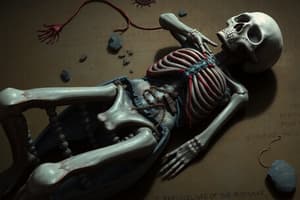Podcast
Questions and Answers
What is the first stage of decomposition called?
What is the first stage of decomposition called?
Fresh
What happens during the Bloat stage?
What happens during the Bloat stage?
Gases build up and give the body a distended appearance.
Describe the Active Decay stage.
Describe the Active Decay stage.
The body begins to lose fluids and mass through purge and scavenging.
What characterizes the Advanced Decay stage?
What characterizes the Advanced Decay stage?
What occurs during the Dry/Skeletal stage?
What occurs during the Dry/Skeletal stage?
Flashcards are hidden until you start studying
Study Notes
Fresh Stage
- Starts immediately post-mortem when blood circulation ceases, causing lividity due to gravity.
- Muscle stiffening occurs through rigor mortis within hours after death.
- Body temperature adapts to the surrounding environment.
- Cellular breakdown begins with autolysis, resulting in enzyme release that may cause skin blisters.
- Anaerobic bacteria in the digestive tract proliferate, generating acids and gases, which contribute to foul odors.
Bloat Stage
- Gas accumulation results in the body developing a distended appearance.
- Increased pressure causes gases and fluids to escape through natural orifices.
- Discoloration appears on the skin as gut bacteria multiply, particularly noticeable around the abdomen.
Active Decay Stage
- Significant loss of bodily fluids and tissue mass occurs via purging and scavenging by insects or vertebrates.
- Presence of large maggot masses is common, accompanied by a stark increase in offensive odors.
Advanced Decay Stage
- Body decomposition rate is influenced by environmental temperatures: heat accelerates while cold decelerates the process.
- Considerable reduction in body mass is evident; soil surrounding the remains shows staining from bodily fluids.
- Soil contamination can temporarily harm local vegetation.
- Maggots will leave the body to pupate, while flies stop laying eggs during this phase.
Dry/Skeletal Stage
- Duration of this stage varies significantly based on environmental conditions.
- Remaining skin, if present, becomes tough and leathery.
- Most of the body is reduced to bones and connective tissue; limited food source for diverse insects.
- Only some beetles and opportunistic insects may use the remains for shelter or feeding.
- Over time, bones may become bleached by sunlight exposure and develop cracks after several years.
Studying That Suits You
Use AI to generate personalized quizzes and flashcards to suit your learning preferences.




